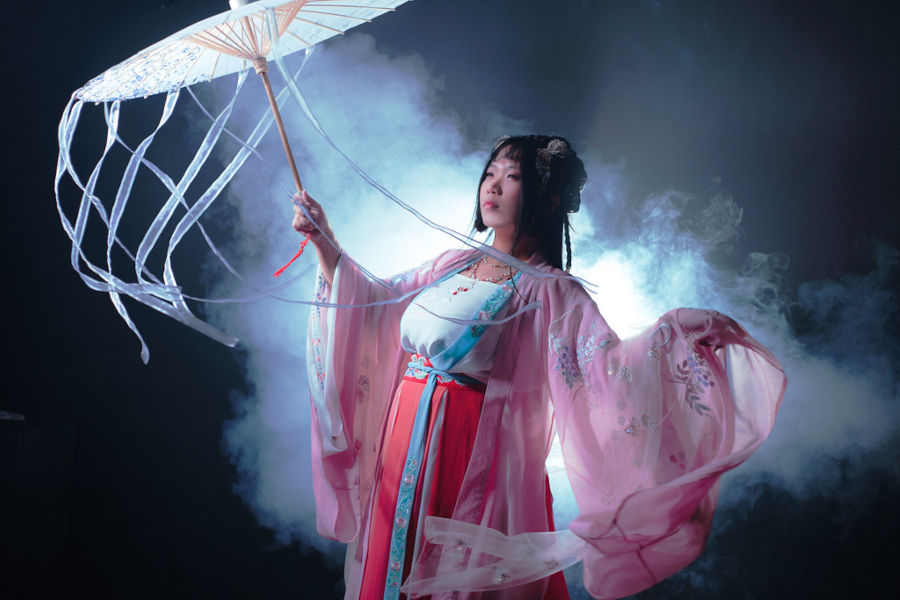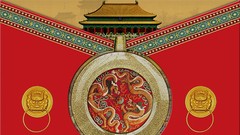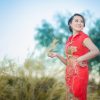
The name Hanfu literally means the clothing of the Han people.
Han Chinese people, or simply Han people (漢族, hàn zú), is the majority ethnic group in China and Taiwan, consisting of 92% of the total Chinese population and 97% of the Taiwanese population. In total, 19% of the world’s population is Han people.
The name “Han” itself originated from the dynasty of Han (206 BCE-220 CE), which is considered as the pinnacle of Chinese civilizations when China was fully united as one country. As a result, many tribes during this time united as one, a single ethnic group.
With these facts being stated, The Hanfu is not exactly the name of the common clothing developed in the time of the Han dynasty, but much sooner than that.
To be exact, the original, most basic form of the Hanfu was developed more than three thousand years ago during the time of the Shang dynasty (1600 to 1046 BCE). The basic Hanfu back then was mainly made of Chinese silk—which was really famous back then for its quality— and colored mainly in green and red. The original’ Hanfu consisted of three main elements:
- Yi: a knee-length tunic that features narrow cuffs, tied with a sash
- Chang: a narrow ankle-length skirt
- Bixi: a knee-length cloth panel attached from the waist
It is worth noting, however, that the Hanfu has significantly evolved from its earliest form after all these centuries.
The Western Zhou Dynasty (1045 – 771 BCE) introduced a class—or caste—system to differentiate between classes. The higher someone’s social status is, the more decorations and accessories are featured on the dress. Social rank will also affect how wide the sleeve and how long the skirt would be.
In general, however, sleeves are then wider compared to the time of the Shang dynasty, and jade decorations were then popular especially for higher-class men and women. The collar was then tied to the right side (crossing the front). Skirts and trousers can greatly vary in length from ground-length to as short as knee-length.
It was only during the time of the Eastern Zhou Dynasty (770–256 BCE) that the shenyi was introduced as an important element of the Hanfu. The shenyi (深衣), literally translated as “deep robe”, is a long full-body garment with the left-side shaped into a corner—which was used to wrap’ the shenyi by fastening it on the chest—. Shenyi was used by anyone regardless of gender and social class, and was an important element of the Hanfu garment until this day.
The Hanfu went out of popularity during the time of the Qing dynasty (1644-1911 CE), during the time when the minority Manchu people ruled China, and thus integrated Manchu fashion (mainly the Qipao or Cheongsam).
Related reading: “Chinese Qipao – All You Need To Know”
After the Qing Dynasty crumbled in 1911 in favor of the Communist rule, China mainly adopt western-style modern clothing—just like the rest of the world—, and so both the Hanfu and the Qipao are not used as day-to-day clothing these days, but are only worn during traditional festivals, religious ceremonies, and as film/drama properties.
How To Wear The Hanfu
As mentioned above, the Hanfu has significantly evolved since the start of the Shang dynasty. The modern Hanfu, generally involve multiple pieces with the male version commonly paired with trousers, and the female version commonly wearing skirts.
We can generally divide the Hanfu into several important elements or pieces:
- Yi (衣): open, cross-collared piece, gender-neutral
- Pao (袍): closed,full-body garment, worn only by men
- Ru (襦): open cross-collar shirt, gender-neutral
- Shan (衫): typically worn over the yi, an open cross-collar jacket
- Chang (裳) or Qun (裙): the skirt, mainly for females but might also be worn by males
- Ku (褲): pants or trousers for males
And then we can divide the Hanfu into three main styles based on usage:
Click here to see some awesome Hanfu dresses for women and girls – Opens in new tab.
Informal Hanfu

Informal Hanfu will always include yi (see above) and pants or a skirt and will involve the shenyi. Then the Hanfu can also involve these elements:
- Zhongdan (中) or Zhongyi (中衣): an inner garment, typically made of white, plain silk or cotton
- Ruqun (襦裙): a top (essentially a blouse) and a wrap-around skirt
- Shanqun (衫裙): newer form of ruqun, involving longer upper garments that can be put out of the skirt
- Kuzhe (褲褶): a short, ancient Chinese military-style coat with trousers
- Fusha (裟) or Daopao (袍): a certain style of robes that is familiar for scholar and Buddhist/Taoist priests. Sometimes also called Hai Qing (青) if it’s designed with a Buddhist style, and De Luo () for Taoist design.
- Zhisheng (直) or Zhiduo (直身): quite similar to shenyi but the sleeve cuffs are closed, except just a small opening so the hands can go through. This style was especially popular during the time of the Ming dynasty (1368 to 1644 CE).
A typical informal Hanfu typically involves just two or three layers, with the Zhongyi typically being the innermost layer. The next layer is the main’ clothing, like Ruqun or Shanqun, among others, and there might be an optional third layer called zhaoshan, which is an overcoat that is open collared.
Online Courses about Chinese Culture from Udemy (Aff.link)

Semi-Formal Hanfu
This style is often worn on cultural festivals, and back then was worn by the upper-ranked individuals and nobility. Characterized by the coat sleeves, that are often deeper than the shenyi, creating a more spacious appearance.
In general, we can make an informal Hanfu into semi-formal by adding these items:
- Zhaoshan (衫): a long coat that is open at the front
- Chang (裳): a tucked skirt
- Bixi (膝): long front cloth panel attached from the waist belt
- Any formal hats and headwear, especially guan (冠) for formal hats, jin () for soft caps, mao () for stiff hats
Check out our “Free Culture Library“. We have compiled some great free resources, about Chinese culture, for your research.
Formal Hanfu

Formal style Hanfu is worn only at religious rituals, and are only worn by religious officials (and back then, emperors).
Formal Hanfu garments might include:
- Different types of Shenyi (深衣):
- Zhiju (直): straight creases
- Quju (曲): diagonal wrapping garment
- Xuanduan (玄端): formal dark robe—the value is quite similar to white tie in Western fashion—
- Lanshan (襴衫), Yuanlingshan (圓衫), or Panlingpao (盤袍): round-collared, very closed formal robe, used for academical dress
Click here to see some awesome Hanfu for men– Opens in new tab.
Hanfu VS Kimono VS Hanbok
Especially for Western people that are not familiar with the cultures, there can be various mixups between the Hanfu (from China), Hanbok (from Korea), and Kimono (from Japan).
Hanfu VS Hanbok
A little bit of historical background, North Korea was regarded as the puppet country of the Chinese emperor during the time of the Ming dynasty. As a result, the Hanbok is closely influenced by the Ming Hanfu
Here are the main differences between the Hanfu and Hanbok:
1. Upper piece position:
- Hanbok: the top outer garment is placed outside to cover the skirt, the dress’s trim is (very) broad and wide.
- Hanfu: the top outer garment is attached to the dress
2.Collar:
- Hanbok: typically involve a v-shaped collar design with a wider bow.
- Hanfu: Hanfu typically involves a y-shaped collar, in fewer cases, a thinner v-shaped collar.

Hanfu VS Kimono
Again, another historical background. Japan sent a large number of envoys to China during the prosperous time of the Tang Dynasty (618 to 907 CE). During this time, Japan and China exchanged cultures, art, education, laws, and fashions.
The earliest form of the Japanese kimono, with that being said, is indeed a replica of the Tang-era Hanfu. Over time, however, the Kimono developed its own designs and characteristics.
1. Fringe/hem:
- Kimono: the fringe of the Kimono is closer to the thighs’ curves, so it’s relatively narrow. Walking in a Kimono is generally harder than Hanfu.
- Hanfu: Hanfu’s hem is relatively wide and loose from the top to the bottom of the dress, so it’s generally easier to move in a Hanfu compared to Kimono
2. Waistband
- Kimono: doesn’t feature a tie, and the waist area is relatively wide
- Hanfu: relatively narrow waistband (but as mentioned above, wider skirt).
3. Sleeves
- Kimono: the sleeves of the kimono are straighter and thinner, and the lower cuffs are stitched closely.
- Hanfu: the hanfu’s sleeves are softer, wider and looser. The inside is usually stitched, and the sleeve’s length is longer than the whole arms (featuring excess)
4. Neckline
- Kimono: the Kimono features a signature square-shaped neckline that can show the multiple collars of the Kimono and the wearer’s natural neckline
- Hanfu: with the Hanfu, the neckline is relatively closer to the back of the wearer’s head, so it’s more ‘curved’
5. Lines
- Kimono: featuring straighter lines that are flatter and more square-shaped. The Kimono lacked the display of the natural body’s curve.
- Hanfu: featuring more curved lines, so is generally more elegant and graceful to look at
End Words
In recent years, there have been various cultural movements to revive the Hanfu as a traditional symbol. Although not as popular as qipao or cheongsam, the Hanfu remains one of the most important identities of China and Chinese descent, symbolizing the richness and longevity of Ancient China’s history.
Today, the Hanfu is worn during various cultural festivals including the Chinese New Year, religious ceremonies, and historical re-enactions.
Click here to see some awesome Hanfu dresses for women and girls – Opens in new tab.
Stay in Touch
 Join our newsletter by using the forms on this website or click here!
Join our newsletter by using the forms on this website or click here! Follow us on Google News
Follow us on Google News Follow us on Facebook
Follow us on Facebook
Featured Image: “Hanfu” by bdrc is licensed under CC BY-NC-ND 2.0


